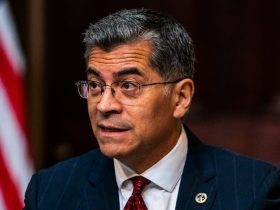Consider former president Donald Trump’s design aesthetic, which one might describe as “Versaillesian.” Given a palette of colors and accoutrements from which to choose when decorating his properties, Trump appears to have regularly opted for “all of the above.”
So, too, with his attacks on political competitors. Trump’s lack of restraint in targeting those who might be obstacles to his power is by now legendary, established unquestionably in the 2016 Republican presidential nominating contest and only reinforced since then. He will attack any opponent with anything at hand.
Usually, though, the attacks are piecemeal, discrete. (N.B.: That does not say “discreet.”) Not so with the attack Trump leveled against Florida Gov. Ron DeSantis (R) on Wednesday. Presented with a palette of options, Trump again seems to have gone with “all of the above” as a distribution strategy.
Some of the attacks even had the benefit of being accurate.
The ostensible trigger for the lengthy statement in which Trump goes after DeSantis is an interview the governor gave to the television host Piers Morgan. DeSantis’s actual criticisms of Trump weren’t that robust, but it was useful to both Trump and Morgan to pretend they were. Trump has spent months shoving DeSantis with slowly increasing strength, hoping that DeSantis would push back, giving Trump an excuse to go buck-wild in response.
Then, over the course of 300-plus words, he did. Here, in the interest of separating fact from fiction — and since this seems like a pretty comprehensive demonstration of how Trump will try to attack DeSantis in the future — is Trump’s statement, sentence by sentence.
“Now that Ron DeSanctimonious is finally admitting he’s in the Race by beginning to fight back, and now that his Polls have crashed so he has no other choice, let me explain the facts.”
This question of when DeSantis actually will announce his campaign has spurred a separate attack on the governor, with a Trump-supporting political action committee filing a complaint against him for allegedly engaging in campaign activity without being a declared candidate. This isn’t likely to go anywhere; there’s a history of people running-but-not-running before announcing formal bids.
Trump’s description of DeSantis “beginning to fight back,” of course, is the “well, he shoved me” rationalization for the entire screed here. And Trump has something of a point. DeSantis has slipped in the polls (not really “crashed” as such) in part, it’s safe to assume, because Trump has been jabbing at him.
“He is, for a Republican, an average Governor, he got 1.2 million less Votes in Florida than me, he fought for massive cuts in Social Security and Medicare, and wanted Social Security minimum age to be raised to 70-years-old, or more. He is a disciple of Paul D. Ryan, and did whatever Ryan told him to do.”
It’s true that DeSantis got fewer votes in his 2022 reelection campaign than Trump got in his 2020 bid — though only about 1 million fewer. But, of course, Trump was running in a presidential election year. DeSantis was running in midterm year, albeit a high-turnout one, and came into Election Day with a sizable popularity lead over his opponent.
More important to voters (if not to Trump personally) are those claims about cutting Social Security. DeSantis, while running for and then serving in the House, aligned with House Republican leaders, including eventual Speaker Paul D. Ryan (R-Wis.), on efforts to revamp Social Security and Medicare spending. It was Republican orthodoxy at the time, a period in which Trump’s engagement in politics was mostly centered on amplifying right-wing cultural fights and attacking President Barack Obama.
The party, now heavily composed of older Americans, has recently softened its approach to federal programs affecting retirees. So Trump is hoping to twist the knife with a group that is likely to make up a lot of the Republican primary electorate.
At the same time, perhaps without meaning to do so, Trump is highlighting one of the main criticisms of DeSantis: that he goes along with what’s popular or appears to be the best conduit to increasing his power.
Speaking of:
“Florida has been successful for many years, long before I put Ron there — It’s amazing what Ocean and Sunshine will do!”
Trump did sort of “put Ron there,” meaning as governor of Florida. DeSantis’s energetic defenses of Trump on Fox News drew Trump’s attention, and he endorsed DeSantis’s bid for the Republican gubernatorial nomination in 2018. DeSantis’s campaign that year was over-the-top in comparing DeSantis to the then-president. To wit:
As for Florida being a popular place to live before DeSantis’s tenure, that’s also true. In 1960, it was the 10th most-populous state in the country. By 1980, it was seventh and by 2000 fourth. In 2014, it passed New York to be the third-most populous state.
“Surprise, Ron was a big Lockdown Governor on the China Virus, sealing all beaches and everything else for an extended period of time, was Third Worst in the Nation for COVID-19 Deaths (losing 86,294 People), Third Worst for Total Number of Cases, at 7,516,906.”
Trump next focuses on the coronavirus pandemic because it’s a point of attack for DeSantis. In the interview with Morgan, the governor criticized Trump’s adhering to recommendations from the government’s former top infectious-disease expert, Anthony S. Fauci. Here, Trump is suggesting that DeSantis’s management of the pandemic exacted a disproportionately heavy toll on Florida residents.
Notice, though, that Florida comes in third on both metrics, according to Trump. But it is also the third-most populous state, so you’d expect those rankings to be what they are.
Adjusted for population, Washington Post data has Florida as the state with the 12th-most cases and 12th-most deaths. That is worse than other populous states and worse than most states in general. Research has shown that the pandemic was especially deadly to Republicans in Florida after vaccines were made available, because rejecting those shots became a partisan marker. DeSantis has made vaccine skepticism an increasing aspect of his administration and outreach to Republicans.
“Other Republican Governors did MUCH BETTER than Ron and, because I allowed them this “freedom,” never closed their States. Remember, I left that decision up to the Governors! For COVID Death Rates Per State, Ron, as Governor of Florida, did worse than New York.”
Again, Trump is trying to neutralize DeSantis’s pitch against pandemic restrictions, suggesting that he was the original “do what you want” politician. Both leaders did implement restrictions, and both quickly realized there was political benefit in lifting them. The Post’s Aaron Blake wrote about this debate in January.
The point about there being more deaths in Florida relative to population than in New York is true. Our data indicates that Florida has experienced 404 deaths per 100,000 residents in comparison with 396 in the Empire State.
“In Education, Florida ranks among the worst in the Country and on crime statistics, Florida ranked Third Worst in Murder, Third Worst in Rape, and Third Worst in Aggravated Assault. For 2022, Jacksonville was ranked as one of the Top 25 Major Crime Cities in the Country, with Tampa and Orlando not doing much better.”
Trump starts getting a little vague here. It’s not clear from what source the education claim comes; a 2021 analysis by U.S. News and World Report puts the state at third in education.
The crime figures, meanwhile, are notoriously flawed. Crime statistics are collected annually by the FBI, but the reporting of data to the FBI’s database varies by municipality, especially since the FBI overhauled what it requests of police departments. Even when data is provided, it is necessarily out of date. That said, it is the case that Jacksonville was deadlier last year than New York City, for example.
“On Education, Florida ranks #39 in Health & Safety in the Country, #50 in Affordability, and #30 in Education & Childcare, HARDLY GREATNESS THERE!”
These figures come from an analysis by WalletHub.
“The fact is, Ron is an average Governor, but the best by far in the Country in one category, Public Relations, where he easily ranks Number One — But it is all a Mirage, just look at the facts and figures, they don’t lie — And we don’t want Ron as our President!”
It is probably true that DeSantis is better than most or all other governors at getting media attention, for what that’s worth. But it is true that many Republican voters prefer candidates other than DeSantis for the 2024 presidential nomination — although, to Trump’s frustration, many of those voters also prefer DeSantis to him.
There’s one more important bit of context to this, of course. Looking at the “facts and figures” presented by Trump depicts only a portion of DeSantis’s record. This is what Trump often does, identifying a few things and then insisting that they are the only things that are important. He’s not in the business of providing an evenhanded view of DeSantis, certainly, but it’s worth remembering that caveat.
After all, Trump doesn’t literally include every design element and paint swatch in his interior designs. At the end of the day, he’s just doing as much as he can to make the sale.








